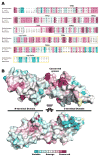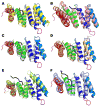Crystal structure of BamD: an essential component of the β-Barrel assembly machinery of gram-negative bacteria
- PMID: 21463635
- PMCID: PMC3098899
- DOI: 10.1016/j.jmb.2011.03.035
Crystal structure of BamD: an essential component of the β-Barrel assembly machinery of gram-negative bacteria
Abstract
Folding and insertion of integral β-barrel proteins in the outer membrane (OM) is an essential process for Gram-negative bacteria that requires the β-barrel assembly machinery (BAM). Efficient OM protein (OMP) folding and insertion appears to require a consensus C-terminal signal in OMPs characterized by terminal F or W residues. The BAM complex is embedded in the OM and, in Escherichia coli, consists of the β-barrel BamA and four lipoproteins BamBCDE. BamA and BamD are broadly distributed across all species of Gram-negative bacteria, whereas the other components are present in only a subset of species. BamA and BamD are also essential for viability, suggesting that these two proteins constitute the functional core of the bacterial BAM complex. Here, we present the crystal structure of BamD from the thermophilic bacteria Rhodothermus marinus refined to 2.15 Å resolution. The protein contains five tetratricopeptide repeats (TPRs) organized into two offset tandems, each capped by a terminal helix. The N-terminal domain contains three TPRs and displays remarkable structural similarity with proteins that recognize targeting signals in extended conformations. The C-terminal domain harbors the remaining two TPRs and previously described mutations that impair binding to other BAM components map to this domain. Therefore, the structure suggests a model where the C-terminal domain provides a scaffold for interaction with BAM components, while the N-terminal domain participates in interaction with the substrates, either recognizing the C-terminal consensus sequence or binding unfolded OMP intermediates.
Copyright © 2011 Elsevier Ltd. All rights reserved.
Figures





Similar articles
-
The Structure of a BamA-BamD Fusion Illuminates the Architecture of the β-Barrel Assembly Machine Core.Structure. 2016 Feb 2;24(2):243-51. doi: 10.1016/j.str.2015.10.030. Epub 2015 Dec 31. Structure. 2016. PMID: 26749448 Free PMC article.
-
Conformational Changes That Coordinate the Activity of BamA and BamD Allowing β-Barrel Assembly.J Bacteriol. 2017 Sep 19;199(20):e00373-17. doi: 10.1128/JB.00373-17. Print 2017 Oct 15. J Bacteriol. 2017. PMID: 28760846 Free PMC article.
-
Functions of the BamBCDE Lipoproteins Revealed by Bypass Mutations in BamA.J Bacteriol. 2020 Oct 8;202(21):e00401-20. doi: 10.1128/JB.00401-20. Print 2020 Oct 8. J Bacteriol. 2020. PMID: 32817097 Free PMC article.
-
Augmenting β-augmentation: structural basis of how BamB binds BamA and may support folding of outer membrane proteins.J Mol Biol. 2011 Mar 11;406(5):659-66. doi: 10.1016/j.jmb.2011.01.002. Epub 2011 Jan 12. J Mol Biol. 2011. PMID: 21236263 Review.
-
The β-Barrel Assembly Machinery Complex.Methods Mol Biol. 2015;1329:1-16. doi: 10.1007/978-1-4939-2871-2_1. Methods Mol Biol. 2015. PMID: 26427672 Review.
Cited by
-
Proteomic and bioinformatic analyses of proteins in the outer membrane and extracellular compartments and outer membrane vesicles of Candidatus Liberibacter species.Front Microbiol. 2022 Sep 26;13:977710. doi: 10.3389/fmicb.2022.977710. eCollection 2022. Front Microbiol. 2022. PMID: 36225379 Free PMC article.
-
Is the C-terminal insertional signal in Gram-negative bacterial outer membrane proteins species-specific or not?BMC Genomics. 2012 Sep 26;13:510. doi: 10.1186/1471-2164-13-510. BMC Genomics. 2012. PMID: 23013516 Free PMC article.
-
bam Lipoproteins Assemble BamA in vitro.Biochemistry. 2013 Sep 3;52(35):6108-13. doi: 10.1021/bi400865z. Epub 2013 Aug 21. Biochemistry. 2013. PMID: 23919461 Free PMC article.
-
Structural snapshots of the β-barrel assembly machinery.FEBS J. 2017 Jun;284(12):1778-1786. doi: 10.1111/febs.13960. Epub 2016 Nov 29. FEBS J. 2017. PMID: 27862971 Free PMC article. Review.
-
Recombinant expression, purification, crystallization and preliminary X-ray diffraction analysis of Haemophilus influenzae BamD and BamCD complex.Acta Crystallogr F Struct Biol Commun. 2015 Feb;71(Pt 2):234-8. doi: 10.1107/S2053230X14027319. Epub 2015 Jan 28. Acta Crystallogr F Struct Biol Commun. 2015. PMID: 25664802 Free PMC article.
References
-
- Tokuda H, Matsuyama S. Sorting of lipoproteins to the outer membrane in E. coli. Biochim Biophys Acta. 2004;1693:5–13. - PubMed
-
- Tamm LK, Hong H, Liang B. Folding and assembly of beta-barrel membrane proteins. Biochim Biophys Acta. 2004;1666:250–63. - PubMed
-
- Koronakis V, Eswaran J, Hughes C. Structure and function of TolC: the bacterial exit duct for proteins and drugs. Annu Rev Biochem. 2004;73:467–89. - PubMed
Publication types
MeSH terms
Substances
Grants and funding
LinkOut - more resources
Full Text Sources
Miscellaneous

